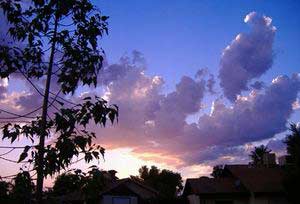Before sunrise and after sunrise, the horizon to the East or West often showcases a brilliant display of red or orange clouds. The early morning clouds at dawn contrast with the evening clouds at sunset.
How are these clouds formed?
 |
Evening Glow (Photo: coffeeworks) |
When the sun rises and sets, sunlight must pass through a dense layer of air before reaching the sky around the horizon. As it travels through this thick layer, shorter wavelengths of light, such as violet and indigo, are scattered significantly, leaving behind only the longer wavelengths of red, orange, and yellow. These colors are scattered by gas molecules, water vapor, and dust in the atmosphere along the horizon, creating the vivid hues of morning and evening clouds.
The more water vapor and dust present, the more beautiful the cloud display becomes. The clouds in the sky also take on vibrant colors.
On August 23, 1883, the island of Krakatoa in Indonesia experienced a powerful volcanic eruption, releasing approximately 18 billion cubic meters of ash that rose to heights of 70,000 to 80,000 meters, blanketing the sky for an extended period. That year, people around the world witnessed a spectacular display of bright red clouds, which were referred to as “blood clouds.”
The vividness of the cloud colors is related to the amount of water vapor and impurities in the air, allowing these clouds to serve as weather indicators. An age-old saying goes, “morning glow means rain, evening glow means cold,” warning us of impending weather changes.


















































